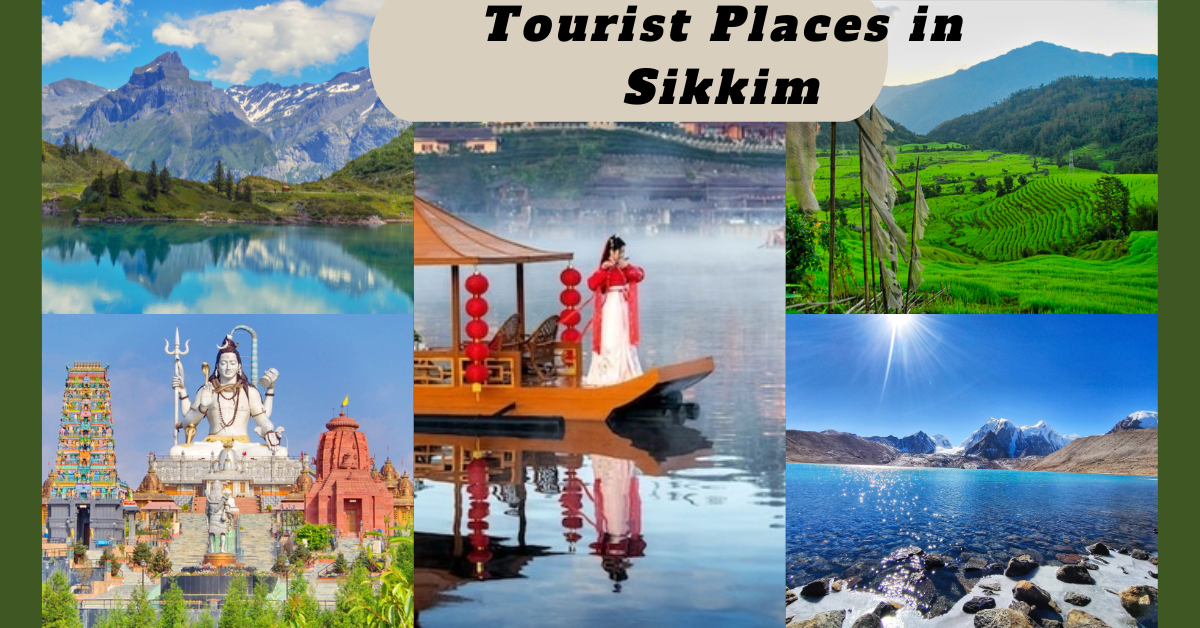Nestled in the lap of the Himalayas, Sikkim is a state that captivates with its pristine landscapes, vibrant culture, and spiritual aura. The top tourist places in Sikkim not only attract nature lovers and adventure seekers but also play a crucial role in shaping the societal ethos. In this blog post, we will embark on a journey through the best and famous tourist places in Sikkim, exploring their relevance, evolution, and potential future developments.

Relevance and Cultural Significance:
- Nathula Pass: Nathula Pass, situated on the Indo-China border, holds strategic importance and cultural significance. It symbolizes Sikkim’s resilience and its role in fostering diplomatic ties between India and China.
- Gurudongmar Lake: Gurudongmar Lake, one of the highest lakes in the world, is not just a natural marvel but also a sacred site for both Buddhists and Sikhs. It reflects the state’s cultural diversity and its commitment to preserving religious and ecological sanctuaries.
- Rumtek Monastery: Rumtek Monastery, a center for Tibetan Buddhism, is a testament to Sikkim’s spiritual heritage. The monastery’s evolution as a hub for religious studies and cultural exchange highlights the state’s commitment to preserving and promoting its unique cultural identity.
Evolution of Tourist Places:
- Tsomgo Lake: Tsomgo Lake, also known as Changu Lake, has evolved into a major tourist attraction. The development of tourism infrastructure, including roadways and amenities, showcases Sikkim’s dedication to providing a balance between visitor experience and environmental conservation.
- Pelling: Pelling, with its breathtaking views of the Kanchenjunga range, has evolved into a popular hill station. The town’s transformation into a tourist destination has been accompanied by sustainable practices, emphasizing the importance of preserving the natural beauty of the region.
- Yuksom: Yuksom, the historic first capital of Sikkim, has evolved into a cultural and trekking destination. The promotion of historical sites and trekking trails reflects the state’s commitment to showcasing its rich history and natural assets.
Impact on Society:
- Cultural Exchange and Unity: Sikkim’s tourist places serve as melting pots for cultural exchange. Visitors from different parts of India and the world engage with the state’s diverse traditions, fostering unity and understanding among people from various backgrounds.
- Economic Growth: The tourism industry in Sikkim plays a crucial role in economic growth. The influx of visitors supports local businesses, including hospitality, transportation, and handicrafts, creating employment opportunities and contributing to the prosperity of the region.
- Preservation of Cultural Heritage: The preservation of cultural heritage is a key aspect of Sikkim’s approach to tourism. Efforts to maintain historical sites, religious monuments, and traditional practices not only attract visitors but also instill a sense of pride and responsibility among the local community.
Potential Future Developments:
- Sustainable Tourism Practices: Future developments should prioritize sustainable tourism practices. Responsible management of visitor footfall, conservation efforts, and the implementation of eco-friendly initiatives can ensure the long-term viability of Sikkim’s cultural and natural landmarks.
- Digital Integration for Enhanced Experiences: Leveraging technology for tourism can enhance visitor experiences. Digital platforms, virtual reality tours, and interactive exhibits can provide a more immersive understanding of Sikkim’s history, culture, and natural beauty.
- Community Empowerment: In the future, there could be increased emphasis on community empowerment through tourism. Involving local communities in the management and promotion of tourist places can ensure that the benefits of tourism are shared, fostering a sense of ownership and pride.
Conclusion:
Sikkim’s best and famous tourist places are not just destinations; they are harmonious notes in a symphony that resonates with the state’s cultural richness, spiritual depth, and environmental beauty. As we stand at Nathula Pass, gaze upon Gurudongmar Lake, or explore the serenity of Rumtek Monastery, it is evident that these landmarks are integral to Sikkim’s societal fabric. Looking ahead, sustainable practices, technological integration, and community engagement can further elevate Sikkim as a model for responsible tourism, where nature, spirituality, and cultural heritage converge seamlessly. Let us celebrate the diversity, embrace the tranquility, and contribute to a legacy that continues to echo in the heart of the Himalayas.

Best and Famous 37 Tourist Places List in India
| Zone | States | |||
| North | Jammu & Kashmir
Himachal Pradesh |
Haryana
Chandigarh |
Delhi
Rajasthan |
Punjab |
| Central | Uttar Pradesh | Madhya Pradesh | Chhattisgarh | Uttarakhand |
| East | Bihar
Sikkim |
Odisha | Jharkhand | West Bengal |
| West | Gujarat
Goa |
Daman Diu | Maharashtra | Dadra Nagar Haveli |
| South | Karnataka
Tamil Nadu |
Kerala
Puducherry |
Andhra Pradesh
Andaman Nicobar |
Telangana
Lakshadweep |
| Northeast | Manipur
Meghalaya |
Mizoram
Assam |
Tripura
Arunachal Pradesh |
Nagaland |
| Southeastern | Ladakh | |||
